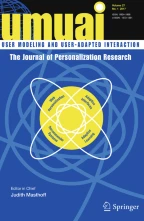132Accesses
14Citations
Abstract
Research on intelligent tutoring systems has mainly concentrated on how to reduce a cognitive load which a student will bear in learning a domain. This load reduction approach contributes to facilitating his/her learning. However the approach often fails to reinforce the student's comprehension and retention. Another approach to tutoring is to apply a load to him/her purposefully. In this paper, we present a framework for cognitive load application and describe a demonstration system. The framework imposes a load on a student who tries to understand an explanation. The important point toward the load application is to provide the student with an optimal load that does not go beyond his/her capacity for understanding. This requires controlling the student's load by means of explanations. In order to implement such load control, it is necessary to estimate how much load the explanation imposes on his/her understanding process. The load estimate depends on his/her understanding capability since the same explanation imposes a different load according to the capability. Therefore a student model representing his/her capability is required. This paper shows how our system accomplishes a proper load application by generating explanations with the load estimate.
This is a preview of subscription content,log in via an institution to check access.
Access this article
Subscribe and save
- Get 10 units per month
- Download Article/Chapter or eBook
- 1 Unit = 1 Article or 1 Chapter
- Cancel anytime
Buy Now
Price includes VAT (Japan)
Instant access to the full article PDF.
Similar content being viewed by others
References
Barr, A., M. Beard and R.C. Atkinson: 1976, ‘The Computer as a Tutorial Laboratory: The Stanford BIP Project’.Man-Machine Studies8, 567–596.
Barron, A.E. and D. Atkins: 1993, ‘Audio Instruction in Multimedia Education: Is Textual Redundancy Important?’. ED-MEDIA '93, Orlando, 39–46.
Carroll, J., R. Mack, C. Lewis, N. Grischkowsky and S. Robertson: 1985, ‘Exploring Exploring a Word Processor’.Human-Computer Interaction1, 283–307.
Cawsey, A: 1991, ‘Generating Interactive Explanations’. Ninth National Conference on Artificial Intelligence, Anaheim, California, 86–91.
Chan, T.W., C.C. Lin, S.J. Lin and H.C. Kuo: 1993, ‘OCTR: A Model of Learning Stages’. Artificial Intelligence in Education '93, Edinburgh, Scotland, 257–264.
Charney, D.H. and L.M. Reder: 1986, ‘Designing Interactive Tutorials for Computer Users’.Human-Computer Interaction2, 297–317.
Chi, M.T.H. and K. VanLehn: 1989, ‘Self-explanations: How students study use examples in learning to solve problems’.Cognitive Science,13, 145–182.
Chi, M.T.H., N. Leeuw, M.H. Chiu and C. LaVancher: 1994, ‘Eliciting Self-Explanations Improves Understanding’,Cognitive Science18, 439–477.
Halff, H.M: 1988, ‘Curriculum and Instruction in Automated Tutors’. In: Polson, M.C. and J.J. Richardson (eds.):Foundations of Intelligent Tutoring Systems, New Jersey: Lawrence Erlbaum Associates, 79–108.
Kashihara, A., T. Hirashima and J. Toyoda: 1993, ‘Impasse-oriented Explanation Planning Based on Explanation Effect Model’. HCI International '93, Orlando, p. 150.
Kashihara, A., K. Matsumura, T. Hirashima and J. Toyoda: 1994, ‘Load-Oriented Tutoring to Enhance Student's Explanation Understanding’.IEICE Transactions on Inf. & Syst.E77-D(1), 27–38.
Kashihara, A., A. Sugano, K. Matsumura, T. Hirashima and J. Toyoda: 1994, ‘A Cognitive Load Application Approach to Tutoring’. Fourth International Conference on User Modeling, Cape Code, 163–168.
Minsky, M.: 1975, ‘A framework for representing knowledge’. In: P. Winston (eds.):The Psychology of Computer Vision. New York, McGraw-Hill.
Moore, J.D. and W.R. Swartout: 1990, ‘Pointing: A Way Toward Explanation Dialogue’. Eighth National Conference on Artificial Intelligence, Boston, 457–464.
Reder, L., D. Charney and K. Morgan: 1986, ‘The Role of Elaborations in Learning a Skill from an Instructional Text’,Memory and Cognition14, 64–78.
Suthers, D., B. Woolf and M. Cornell: 1992, ‘Steps from Explanation Planning to Model Construction Dialogue’. Tenth National Conference on Artificial Intelligence, San Jose, Calif., 24–30.
Suthers, D.: 1994, ‘Strategies for Sequencing as a Planning Task’. Seventh International Workshop on Natural Language Generation, Kennebunkport, Maine, 29–36.
VanLehn, K.: 1988, ‘Toward a Theory of Impasse-Driven Learning’. In: H. Mandl and H. Lesgold (eds.):Learning Issues for Intelligent Tutoring Systems, New York: Springer-Verlag, 19–41.
Wenger, E.: 1987,Artificial Intelligence and Tutoring systems. Los Altos, Calif.: Morgan Kaufmann Publishers.
Author information
Authors and Affiliations
The Institute of Scientific and Industrial Research, Osaka University, 8-1, Mihogaoka, Ibaraki, 567, Osaka, Japan
Akihiro Kashihara, Tsukasa Hirashima & Jun'ichi Toyoda
- Akihiro Kashihara
You can also search for this author inPubMed Google Scholar
- Tsukasa Hirashima
You can also search for this author inPubMed Google Scholar
- Jun'ichi Toyoda
You can also search for this author inPubMed Google Scholar
Rights and permissions
About this article
Cite this article
Kashihara, A., Hirashima, T. & Toyoda, J. A cognitive load application in tutoring.User Model User-Adap Inter4, 279–303 (1994). https://doi.org/10.1007/BF01099822
Received:
Revised:
Issue Date:


